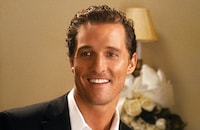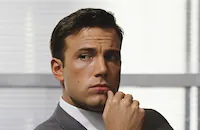Dazed and Confused
Brief Synopsis
Cast & Crew
Richard Linklater
Renée Zellweger
Michael Gillespie
Jason London
Milla Jovovich
Erika Germinder
Film Details
Technical Specs
Synopsis
It's Texas, 1976, and the last day of high school. A group of seniors celebrate getting stoned, getting lucky and contemplating what lies ahead.
Director
Richard Linklater
Cast
Renée Zellweger
Michael Gillespie
Jason London
Milla Jovovich
Erika Germinder
Autumn Barr
Sasha Jenson
Travis Johnson
Zeke Mills
Kim Arnette Krizam
Cole Hauser
Adam Goldberg
David Blackwell
Jason O Smith
Mona Lee Fultz

Matthew Mcconaughey
Diane Perella
Katherine Asher
Catherine Morris
Deena Martin
Jacob Jones
Parker Brooks
Parker Posey
Christine Harnos
John L Martin
Nicky Katt
Zach Taylor
Joey Lauren Adams
Marissa Ribisi
Rick Moser
Wiley Wiggins
Doug Taylor
Jeremy Fox

Ben Affleck
Zoe Grief
Esteban Powell
Julius Tennon
John Swasey
Cathleen Cunnigham
Rory Cochrane
Mark Vandermuelen
Shawn Andrews
Michelle Rene Thomas
Richard Dillard
Terry G Mross
Anthony Rapp
Christin Hinojosa
Pricilla Kinser
Heidi Cole Trenbath
Crew
Sandra Adair
Sarah Addington
Dee Allen
Frank Beard
Jean Black
Ritchie Blackmore
Harold Brown
Steven Brown
Michael Bruce
Boudleaux Bryant
Terence Butler
John Cameron
Lincoln Chase
Allen Collins
Brian Connolly
Alice Cooper
Alice Cooper
Lee Daniel
Sean Daniel
Rick Derringer
Rick Derringer
B B Dickerson
Willie Dixon
Katherine Dover
Brian Downey
Bob Dylan
Bob Dylan
Angelina Fontana
Kim V. Fowley
Peter Frampton
Peter Frampton
John A Frick
Mick Gallagher
Holly Gent
Karen Ruth Getchell
Billy F Gibbons
Ian Gillan
Roger Glover
Jerry Goldstein
Tom Hamilton
Bob Harper
Sally J Harper
Dan Hartman
Dusty Hill
Anthony Iomni
Jim Jacks
Janice Janecek
Rob Janecka
Catherine Jelski
Harvey Jett
Joan Jett
Lonnie Jordan
Alma Kuttruff
Fred M. Lerner
Jacque Levy
Richard Linklater
Richard Linklater
Tricia Linklater
Jon Lord
Philip Lynott
Jim Mangrum
Jennifer Mccauley
Stephanie Meyer
Charles W Miller
Steve Miller
Ted Nugent
Ted Nugent
John Osbourne
Lee Oskar
Ian Paice
Deborah Pastor
Jenny C Patrick
Dave Peverett
Don Phillips
Steve Priest
Malcolm J Rebennack
Andy Scott
Howard Scott
Gene Simmons
John Siomos
Mike Somerville
Derek St Holmes
Paul Stanley
Tim Leary Swan
Gabor Szitanyi
Mike Tucker
Steven Tyler
Ronnie Van Zant
Dixie D Walker
Anne Walker-mcbay
War
Bill Ward
Rick Wills
Edgar Winter
Film Details
Technical Specs
Articles
Dazed and Confused - Richard Linklater's Ode to the '70s - DAZED AND CONFUSED on DVD
As with Criterion's release of Linklater's previous Slacker, the new Dazed and Confused rights some serious home video wrongs, and shows proper respect to an increasingly rare being: a movie that actually deserves a two-disc special edition. Set over the last day of school in May 1976, and the night of celebrating that follows, Dazed and Confused is like a lavishly laid-out smorgasbord. You can take whatever you please from it. You want drink-and-drugs humor? Scoop it up. You want coming-of-age drama? Help yourself. You want rowdy teen comedy? You got it. And if you stir them all together, you might get something tastier than the sum of its ingredients.
The writer-director had already thrown together a boatload of askew perspectives in his alternative hit Slacker, set among the world of post-graduates in the Texas college town of Austin. In Dazed and Confused, he finds another crossroads to bring out another blend of soul-searching and hedonism: adolescence. There are forks ahead in the road traveled by the teens in Dazed and Confused, decisions to be made: Should I be the sort of person who lets authority figures dictate with whom I hang around? Should I back down from a fight and become afraid of confrontations for the rest of my life? Should I socialize only with people like me or should I be open to other sorts of people? These are the sorts of questions the movie's 1976 teenagers answer through their actions. But, just as often, they ponder the unquestionable: the need to have fun, whether it's by playing pool or pinball, talking with that girl you think might like you or sharing beers and bongs with your buddies. Although they wouldn't want to admit it, the serious and the fun have equal weight in these high-schoolers' Bicentennial brand of life, liberty and the pursuit of happiness.
It's that mix that earns Dazed and Confused its spot in the holy trinity of high school movies, along with American Graffiti and Fast Times at Ridgemont High. Like its predecessors, not a whole lot happens in Dazed and Confused (named for the Jake Holmes song Led Zeppelin appropriated), but that's what makes its music-filled tale of jocks, brains and townies seem so real. The movie makes its good times especially memorable by tempering them with bittersweet drama and spreading it over a panorama of characters. The results are iconic, both of their time and timeless.
There's also a blend of the timely and the timeless in the Criterion double-DVD's extras. On one hand, the set overflows with behind-the-scenes footage from the movie's 1992 production (auditions, interviews, on-set footage), but the person who shot much of that footage, documentary director Kahane Corn, didn't finish her film about the making of Dazed and Confused until 2005, after she revived its production and shot more footage at the 2003 10th reunion of the movie's release (her Making Dazed, included here, aired on American Movie Classics in 2005). Making Dazed manages to simultaneously give a close-up of the movie's production and a look back, with its mix of 1992 and 2003 interviews with Linklater and cast members. Linklater's battles with his co-producers and the studio come up, of course, but so do more pleasant subjects, like the generous creative relationship between Linklater and his young cast (which includes the likes of Ben Affleck, Parker Posey, Cole Hauser, Adam Goldberg and Joey Lauren Adams), the way those actors bonded with each other and the emergence of Matthew McConaughey and his character, Wooderson, whose presence in the movie increased thanks to the actor's sly performance.
There's a similar blend of tapping into 1992 creative energies and present-day reflection in Linklater's audio commentary. That his audio commentary is insightful, irreverent and amusing is a given. Could anyone who conceived and pushed Dazed and Confused through a Hollywood studio be anything but those things? After the very independent movies It's Impossible to Learn to Plow by Reading Books and Slacker, Dazed and Confused was Linklater's first movie for a studio, in this case Universal. The battles over budget, shooting schedule, what in the script was important and how to release the movie were many, and the scars have not entirely healed. He especially laments over putting up with a studio peering over his shoulder while filming and then having his movie get only an independent-style limited release, calling it "the worst of both worlds."
Those battles over shooting little moments that were literally essential to Linklater come up in the commentary, as do his recollection of things that inspired the movie, both on a personal and creative level. Not surprisingly for this movie, both levels involve a car. "The absolute kernel for this movie, in my memory, was a night in 1975, freshman in high school, driving around in South Houston...," Linklater says. "We never really left the city area, but we drove about 160 miles. A couple tanks of gas, everyone pitching in. And we listened all night to ZZ Top's Fandango." His original conception was to, in a sense, recreate this night: "My first idea was more an experimental idea, not a studio film," he says a little later. "To set the entire movie in the car. You never really leave the car.... Other cars pull up and you interact." But, after Slacker became an alternative hit during the summer of 1991 and Hollywood studios wanted to hear Linklater's other movie ideas, he seized the opportunity to turn the experimental art film into "my teenage rock and roll movie." During the movie's memorable opening sequence, he points out that just the rights to use Aerosmith's "Sweet Emotion" cost more than he spent to make Slacker. Indeed, the music ate up a lot of the budget because, as he also says, "This movie, to me, started with the music."
Sometimes the music is there for a very specific reason-Linklater says he remembers entering his local pool-hall hangout as Bob Dylan's "Hurricane" played on the jukebox, so he used it for a group of characters' entrance there-but choosing the tunes also taught him lessons for making the entire movie. On reluctantly including Alice Cooper's "School's Out for Summer," he wisely says, "It's kinda obvious. But that's like the movie in general. I have to take on these clichés, and just make them work. Because the whole thing's a cliché. A teenage movie is a cliché. I just had to make it work in my own way." Linklater expresses regret that, "like in high school," the guys took over the movie and that he let down the female characters. Along with a cut subplot about the mysterious statues on which the kids paint Kiss faces (they turn out to be stolen from the local bank), the most interesting of the 17 deleted scenes here is a fun little drunken conversation between Posey's Darla and Adams' Simone that the two actresses wrote, after offering to pump up the female side of the story.
For more information about Dazed and Confused, visit The Criterion Collection.
by Paul Sherman

Dazed and Confused - Richard Linklater's Ode to the '70s - DAZED AND CONFUSED on DVD
Quotes
Trivia
Miscellaneous Notes
Released in United States Fall September 24, 1993
Released in United States on Video March 30, 1994
Released in United States August 1993
Released in United States September 1993
Released in United States 2013
Released in United States 2016
Shown at Locarno International Film Festival (in competition) August 5-15, 1993.
Shown at Boston Film Festival September 13-23, 1993.
Originally scheduled for release in USA on video February 23, 1994 but postposted due to its continued theatrical success.
Released in United States Fall September 24, 1993
Released in United States on Video March 30, 1994
Released in United States August 1993 (Shown at Locarno International Film Festival (in competition) August 5-15, 1993.)
Released in United States September 1993 (Shown at Boston Film Festival September 13-23, 1993.)
Began shooting July 13, 1992.
Released in United States 2013 (Free Screenings)
Released in United States 2013 (20th Anniversary Screening)
Released in United States 2016 (Special Events - With live commentary by Richard Linklater and Jason Reitman)
Completed shooting August 27, 1992.













